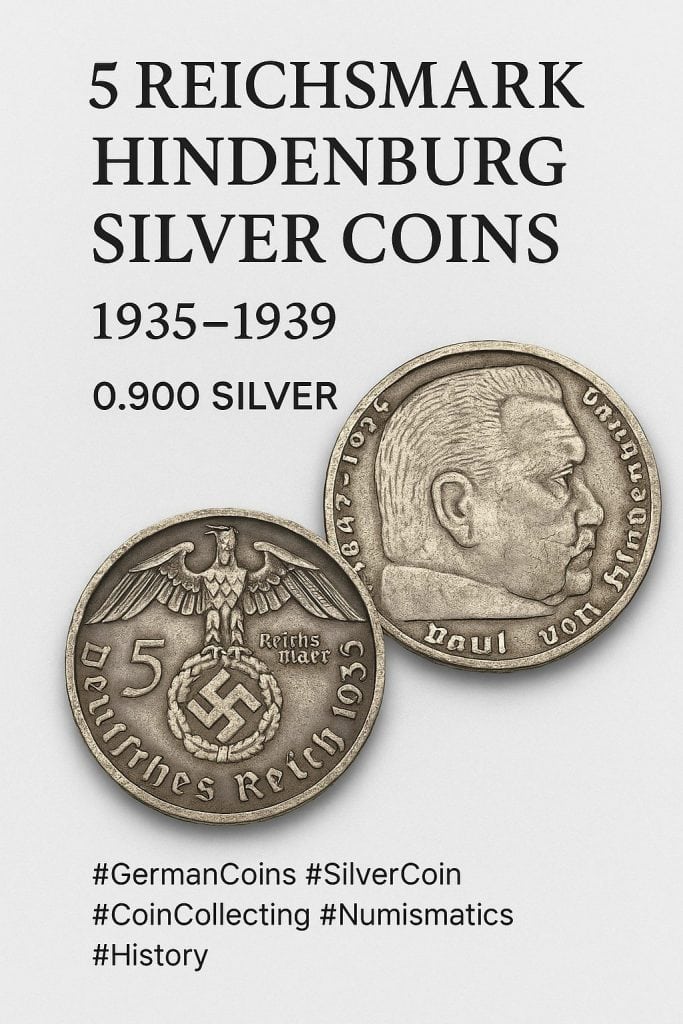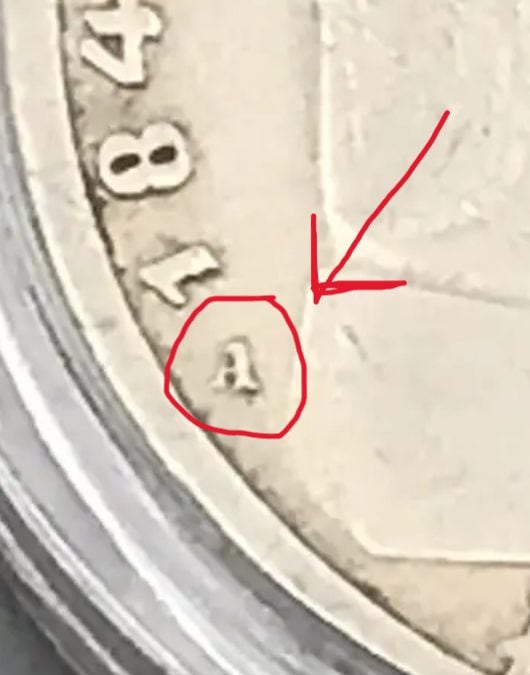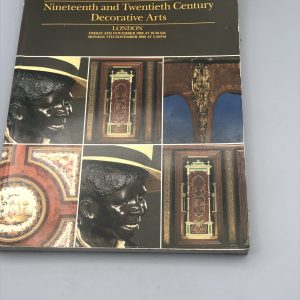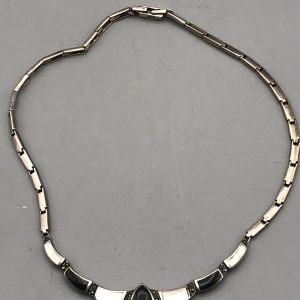READ MORE ABOUT ANTIQUES
The 5 Reichsmark Hindenburg Silver Coins (1935–1939): History, Silver Content & Mint Marks Explained

🪙 Introduction: The Last Silver Circulating Coinage of Pre-War Germany
Between 1935 and 1939, Germany issued a series of 5 Reichsmark silver coins featuring the portrait of Paul von Hindenburg, the former German President whose image symbolized continuity between the Weimar Republic and the early Third Reich.
Struck in 0.900 fine silver, these coins represent the final era of substantial silver circulating currency in Germany before wartime metal restrictions ended traditional minting.
Collectors prize these pieces for their historical weight, classic engraving style, and solid intrinsic silver value.
⚔️ Historical Background
After Hindenburg’s death in 1934, his portrait was chosen for the newly redesigned Reichsmark denominations.
The 5 Reichsmark served as the country’s premier high-value coin, circulating alongside the smaller 2 Reichsmark and the standard 1 Reichsmark denominations.
From 1936 onward, the reverse carried the German eagle emblem and swastika, replacing earlier Weimar-era designs — marking the political transformation of the period.
🧭 See detailed mint mark tables in this collector’s guide.
Mint Marks and Where the Coins Were Struck. Each 5 Reichsmark coin carries a small mint mark letter located just beneath Hindenburg’s bust.
This letter identifies the mint where the coin was struck:
| Mint Mark | City / Mint | Region | Notes |
|---|---|---|---|
| A | Berlin | Brandenburg | Highest output – most common issues |
| D | Munich | Bavaria | Medium mintage, sought after |
| E | Muldenhütten | Saxony | Smaller mint, moderate scarcity |
| F | Stuttgart | Baden-Württemberg | Low mintage, collectible |
| G | Karlsruhe | Baden-Württemberg | Scarce issues |
| J | Hamburg | Hamburg | Northern mint, moderate mintage |
Collectors often seek specific mint marks, as scarcity and condition significantly affect market value.
Below are close-up Images displaying a variety of mint marks.
🥇 How Much Silver Is In A 5 Reichsmark
Silver Content and Alloy Details. All 5 Reichsmark and 2 Reichsmark Hindenburg coins struck 1935–1939 share these core specifications:
| Specification | Detail |
|---|---|
| Metal | 0.900 silver (90% Ag) |
| Weight | 13.88 g |
| Pure silver content | 12.49 g (≈ 0.401 troy oz) |
| Diameter | 29 mm |
| Edge | Inscribed: “Gemeinnutz Geht Vor Eigennutz” (“Public good before self-interest”) |
🔄 When Did They Stop Using Silver In The 5 Reichsmark
The End of Silver Coinage. By 1939, with war production escalating, silver coinage became unsustainable.
Post-war Reichspfennig and later Reichsmark issues were struck in nickel, aluminium-bronze, or zinc alloys, effectively ending precious-metal circulation coins in Germany.
💰 Collector Guide: Appeal and Values
Values depend on:
- Mint mark rarity
- Year (1935–1939)
- Condition / grade (circulated vs. uncirculated)
- Historical preservation and toning
Typical value ranges (as of 2025):
- Circulated (Fine–Very Fine): £15–£25
- Extremely Fine / About Uncirculated: £35–£60
- Brilliant Uncirculated or slabbed: £75–£150 +
The scarcer mints (F, G) attract small premiums. The Berlin “A” issues are common but remain desirable for type collections.
🧼 How to Care For and Store 5 Reichsmark Hindenburg Coins
Proper handling and storage are essential to preserving the value and integrity of your 5 Reichsmark Hindenburg silver coins. These historical pieces not only carry monetary worth, but also bear witness to a complex era in European history — and should be treated with care and respect.
❌ Never Clean or Polish With Chemicals
One of the most common — and costly — mistakes collectors make is attempting to “improve” their coins by cleaning them.
- Do not use silver polish, vinegar, baking soda, or ultrasonic cleaners. These substances can strip away the natural patina, reducing the coin’s collector value significantly.
- A cleaned coin is often worth less, even if it looks shinier. Collectors and grading services like PCGS and NGC penalize cleaned coins.
🌫️ The Patina is Part of the History
The patina — the light grey or dark surface tone — is a natural result of the coin’s silver content reacting to air over decades. It serves as:
- A sign of authenticity
- A protective layer against further corrosion
- A visual indicator of age and provenance
Coins with original patina are often more desirable than shiny or artificially brightened ones.
🧤 Handling Tips
- Always handle coins by the edges, never the faces.
- Wear cotton gloves if possible to avoid transferring oils or acids from your skin.
- Avoid touching them unnecessarily — even clean hands can leave marks over time.
📦 Best Storage Practices
To preserve your coins for decades to come:
| Storage Method | Notes |
|---|---|
| 2×2 coin holders (cardboard with Mylar window) | Inexpensive and safe for most silver coins |
| Plastic coin flips (PVC-free) | Make sure they’re archival quality and PVC-free to prevent chemical damage |
| Capsules or airtights | Ideal for high-grade coins; keep moisture and air out |
| Coin albums (acid-free pages) | Great for display and protection; ensure album is archival quality |
| Silica gel packs | Place in storage boxes to reduce humidity and prevent tarnish |
| Avoid attics, basements, or humid rooms | Stable temperature and low humidity are key |
🛑 What to Avoid
- Ziplock bags (can trap moisture)
- Humid storage locations
- Contact with rubber bands or paper envelopes (they contain sulfur or acids)
🔄 If You Already Have a Cleaned Coin
If the coin was previously cleaned, don’t panic. It may still have bullion value or historical significance. Just avoid further cleaning and store it properly going forward.
✅ Summary
Preserving the original condition of your 5 Reichsmark Hindenburg coins helps maintain their numismatic and historical value. When in doubt — don’t clean, don’t touch, and don’t guess. Proper storage and gentle handling go a long way toward safeguarding your investment and legacy.
🔍 Where to Find 5 Reichsmark Hindenburg Silver Coins
Whether you’re starting a collection or looking to expand it, 5 Reichsmark Hindenburg coins can still be found in a variety of places — both in-person and online. Some of the most unexpected finds can happen in the most casual settings. We also have multiple examples for sale here in our store at AntiquesArena
🛒 Common Sources for Collectors:
| Source | Description |
|---|---|
| Car Boot Sales | 💡 A hidden treasure trove! You found yours here — and many others do too. Sellers often don’t realize the true value of what they’re selling. Look for coin boxes, trays, or estate clear-outs. |
| Antique Fairs & Markets | Great for finding coins mixed in with other collectibles. Dealers may have ungraded examples at fair prices. Always inspect the coin closely. |
| Coin Shops & Dealers | Specialised dealers offer authenticity guarantees and can help with grading — but may charge higher premiums. Still a reliable source for rarer mint marks. |
| eBay & Online Marketplaces | Convenient and wide-reaching, but buyer beware: research the seller, read reviews, and avoid listings with only stock photos. Use PayPal or buyer protection services. |
| Auctions (Local & Online) | Coins often appear in estate sales, militaria lots, or general antique auctions. Try: |
- Easylive Auctions
- The Saleroom
- Catawiki
- Heritage Auctions (for higher-end pieces) |
🧭 Tips for Hunting:
- Bring a jeweller’s loupe or 10x magnifier to inspect mint marks and surfaces.
- Have a basic idea of what mint marks are scarce (e.g., F, G) so you can spot value quickly.
- If you’re buying online, ask for clear obverse, reverse, and edge images before bidding.
⚠️ Spotting Fakes: What to Watch Out For
Unfortunately, due to their popularity and silver content, 5 Reichsmark Hindenburg coins have been replicated, counterfeited, and cast — especially in online marketplaces.
🔎 Key Signs of a Fake:
| Red Flag | Details |
|---|---|
| Soft Details / Poor Strike | Authentic coins have sharp engraving, especially around Hindenburg’s face, the eagle, and lettering. Cast fakes often look “blurry” or rounded. |
| Wrong Weight | Official coins should weigh 13.88 grams. Fakes are often underweight (11–13g) or overweight due to different metals. Use a digital scale. |
| Non-Silver Sound | Tap a real silver coin and listen for a clear “ring.” Fakes with base metals have a dull, short thud. This is called the ping test. |
| Unusual Toning | Artificial patina can look “painted on” or strangely uniform. Natural toning is random and uneven. |
| Edge Lettering Errors | The edge should read “Gemeinnutz geht vor Eigennutz” in crisp Gothic script. Blurred or missing text = red flag. |
| No Mint Mark | All genuine 5 Reichsmark coins have a clear mintmark (A, D, E, F, G, J) under Hindenburg’s neck. If it’s missing — be suspicious. |
| Wrong Metal | Use a magnet test: 90% silver is not magnetic. If your coin sticks, it’s not real silver. |
🧠 Pro Tip:
If you’re unsure, compare the coin to a verified authentic example side by side — either online or from a reputable dealer. Or, consider sending it to a third-party grader like NGC or PCGS for verification.
🧠 Quick Facts (Snippet-Friendly Section)
What is the silver content of a 5 Reichsmark Hindenburg coin?
→ Each coin contains 12.49 g of pure silver (0.900 fine).
What years were Hindenburg 5 Reichsmark coins made?
→ Minted 1935 to 1939, inclusive.
When did Germany stop using silver in its coins?
→ 1939 marked the last year of 0.900 silver issues before wartime alloy coinage replaced them.
Where was the 5 Reichsmark coin minted?
→ Berlin (A), Munich (D), Muldenhütten (E), Stuttgart (F), Karlsruhe (G), and Hamburg (J).
Are 5 Reichsmark coins valuable?
→ Common examples track silver bullion value; rarer mints and uncirculated grades command collector premiums.
🏁 Conclusion
The 5 Reichsmark Hindenburg silver coins stand as enduring artifacts of interwar Europe — combining fine silver content, political symbolism, and historic design.
Whether collected for their bullion value, aesthetic appeal, or historical significance, they remain a tangible link to one of the most pivotal decades in modern history.

Table of Contents












